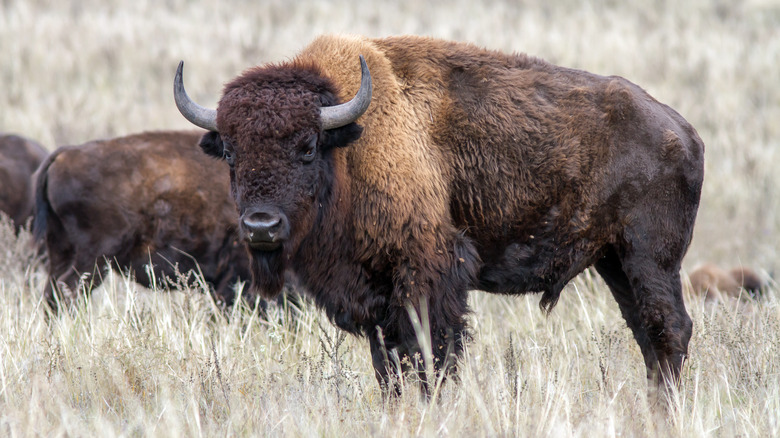The Time Researchers Ate A Mummified Bison
Bison meat has gained significant popularity as an occasional alternative to beef, often popping up on menus under its colloquial name, "American buffalo." According to Healthline, bison and beef offer similar levels of protein and key nutrients such as iron and zinc, and both provide the nine essential amino acids your body demands. However, bison is significantly lower in calories and fat. Not only does it have less total fat, but it also contains just half as much saturated fat as beef.
According to The New York Times, consumption of bison meat has been on the rise since the early 2000s, partially spurred on by billionaire Ted Turner's efforts to promote bison ranches in the United States. Between the early 1970s, when Turner started his own ranch, and the 2010s, the American bison population, rose from just 30,000 to 500,000.
We tend to think of bison as distinctly American animals, memorialized in countless natural history museum dioramas depicting life in the Great Plains. However, these animals didn't appear in North America until the last Ice Age, after crossing the frozen Bering Strait from Eurasia (via the Yukon Beringia Interpretive Centre). These early American pilgrims were known as steppe bisons, now-extinct precursors to modern bison species. As it turns out, though, their extinction couldn't prevent human beings from getting a taste.
A meal 50,000 years in the making
The Yukon Beringia Interpretive Centre notes that steppe bison migrated as far south as Mexico, but also remained in the Alaska region, where many were frozen in permafrost ice. They lay there for millennia until the region became a gold mining hotspot. In 1979, Ruth and Walter Roman were using a hydraulic mining hose on their property near Fairbanks when they uncovered something even rarer than a 24-karat nugget: A mummified steppe bison, which they turned over to the University of Alaska. Researchers estimated the bovine had died 36,000 prior, and because it was coated in vivianite, a blue mineral, they named it "Blue Babe."
Atlas Obscura reports that updated research puts Blue Babe's age at 50,000 years, but the story really got interesting when paleontologist Dale Guthrie decided he'd like to know what it tasted like. He cut off a small piece of the bison's flesh near the neck and made it into a stew for a dinner party.
Guthrie wrote that the thawed meat "gave off an unmistakable beef aroma" and reported, "the taste was delicious, and none of us suffered any ill effects" (via Food History Almanac: Over 1,300 Years of World Culinary History, Culture, and Social Influence). However, Guthrie could only speak for himself, and NPR reports that his wife Mary Lee later said it was like beef jerky, but worse. As for the rest of Blue Babe, it's on display at the University of Alaska Museum of the North.

